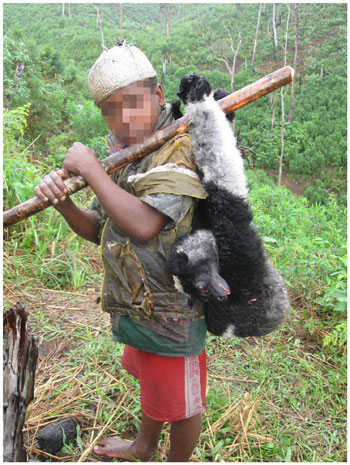
The indri lemur is one of the most commonly hunted for bushmeat, though it is listed as Endangered. Photo by: Rhett A. Butler .
Conservationists have often found that some cultural norms, religious beliefs, and taboos play a role in holding back traditional peoples from overusing their environment. Examples of such beliefs include days wherein one cannot hunt or fish, or certain species or regions that are off limits to exploitation. But the influence of the modern world can rapidly extinguish such beliefs, sometimes for the better, in other cases not. In many parts of Madagascar, lemurs are off the menu. These primates, found only in Madagascar, play a big role in Malagasy ‘fady’ or taboo-related folk stories: lemurs are protectors and, in some cases, even relatives. However, according to a new paper in PLoS ONE an influx of migrants, widespread poverty, lack domestic meat, and poor law enforcement has caused a sudden rise in eating lemurs, many of which are already near extinction due to habitat loss.
“Our observations suggest that young men have more available cash and leisure time due to the transition from subsistence farming to panning for gold, and they spend more time in local bars, eating fried meat snacks with their drinks,” explains co-author of the new paper, Julie Razafimanahaka, from local conservation NGO Madagasikara Voakajy. Some of those fried meat snacks are wild lemurs.
Many of these young men are immigrants to eastern Madagascar and so bring new values with them, making it easy for them to break taboos. Christian missionaries have also brought in new ideas, eroding traditional beliefs. Once a taboo is openly broken it becomes easier and easier for others to break.
 Boy in Madagascar with a dead indri lemur. Photo © Madagasikara Voakajy. |
Surveying villagers in eastern Madagascar, the study found that 95 percent of 1,154 households have consumed a protected species with 45 percent having eaten over 10 protected species. Although for the most part these households eat meat rarely, about a quarter of the time, and just over 1 percent of meals in a three-day-recall included non-fish wild meat, such as lemurs. But even a small percentage could mean the difference between survival and extinction for some species.
Lemurs are slow reproducers: Lemurs are slow reproducers: females of larger species bear offspring only once every few years and young lemurs may take nine years to mature. They have also been facing decades of habitat destruction. This has caused 47 percent of lemurs evaluated by the IUCN to be threatened with extinction (including Critically Endangered, Endangered, Vulnerable, and Near Threatened), while most of the remaining lemurs (44 percent) have been classified as Data Deficient since researchers simply lack enough information to make a judgement. Only 8 species of lemur are deemed “safe” by the IUCN, listed as Locally Common.
Paying locals to monitor villages, the study also counted actual trade in lemurs. Nearly 500 lemurs of nine different species were sold in the monitored villages over 2 years. Two species listed as Endangered: indri (Indri indri) and diademed sifaka (Propithecus diadema) were the most common. The monitors also recorded nine black-and-white ruffed lemurs (Varecia variegata) killed, a species listed as Critically Endangered. Killing lemurs didn’t seem widespread in the villages, but “evidence from our local monitors suggests that a large number of the indri were killed by a few individuals who own guns and kill lemurs to sell.”
As a desperately poor nation, one of Madagascar’s bright spots economically is wildlife tourism. However, without lemurs tourism is likely to quickly dry up.
“Madagascar’s amazing wildlife, especially its world famous lemurs, are so important for the future of the country. They are worth much more to the economy alive than as meat,” says co-author Julia Jones of Bangor University.
Lemurs aren’t the only species being hunted, others include the lowland streaked tenrec (Hemicentetes semispinosus), vasa parrots, the truly bizarre cuckoo roller (Leptosomus discolor), Madagascan flying fox (Pteropus rufus), common tenrec (Tenrec ecaudatus), and red-billed teal (Anas erythrorhyncha), the last three of which are listed as ‘game species’ (meaning they are legal to kill) even though the flying fox is listed as Vulnerable by the IUCN Red List. In addition hunting for the radiated tortoise (Astrochelys radiata) has pushed this species from abundant not long ago to Critically Endangered today. Standing hunting taboos regarding these species are also shifting.
“There is evidence that in some cases traditional rules which managed harvested species (for example preventing hunting of pregnant tenrecs, or trapping of fruit bats at the roost) are breaking down over time,” the authors write.
Solutions?

Critically Endangered black-and-white ruffed lemurs are also a target. Photo by: Rhett A. Butler.
The household interviews came away with some positive news: most importantly, respondents largely prefer domestic meats to wild meat.
“[This] suggest that projects which increase the availability of domestic meat and fish may have success at reducing demand,” write the authors.
 Deforestation has endangered many species and caused erosion throughout Madagascar. Photo by: Rhett A. Butler. |
The focus so far has been on chickens given that they are cheap and easy to raise. However, chicken perish quickly in the region to an unidentified disease. Currently scientists are exploring what is killing off the chickens and hope that it will prove an easy fix.
“If domestic meats could be farmed more reliably and were therefore cheaper, the pressure on wild species may be reduced. More effort is needed to improve domestic animal husbandry methods and disease control in rainforest areas,” says co-author Richard Jenkins of Bangor University.
The authors also suggest that existing laws need to upheld to discourage eating protected species. Currently, killing a lemur comes with a punishment of between $5 and $200 and/or a month to two years in jail, but the law is rarely enforced, though most lemur selling is done in relative secret.
The overall situation is complicated by poverty. Most people in Madagascar live on less than a dollar per day and nearly half of the children under five years are malnourished.
“Rural Malagasy diets are very short of protein so if people who rely on bushmeat for at least part of their food are no longer able to hunt then some, already under nourished people, will suffer increased deprivation. However, efforts to reduce illegal hunting are necessary to protect the ecotourism industry upon which the livelihood of many people, including some rural poor, depends (directly or indirectly),” the authors write.
Combating poverty in the midst of saving endangered species are two issues conservationists and NGOs face everyday in Madagascar.
Education is also a problem. Conservationists often say how people in Madagascar are entirely unaware lemurs are not found worldwide. Efforts are ongoing to provide environmental education, including a public campaign that argues lemurs are “not meat.”
But conservationists are racing against the clock.
“Since humans arrived in Madagascar, many of the island’s largest terrestrial vertebrates have gone extinct, a loss blamed at least in part on hunting. If further extinctions are to be avoided, urgent action is needed to reduce hunting of protected species,” the authors write.

Another hunted species: lowland streaked tenrec. Photo by: Rhett A. Butler.
Lemur species according to the IUCN Red List
Least concern: 8
Near Threatened: 5
Vulnerable: 14
Endangered: 18
Critically Endangered: 8
Data Deficient: 42
Not Evaluated: 6
CITATION: Jenkins RKB , Keane A , Rakotoarivelo AR , Rakotomboavonjy V , Randrianandrianina FH , et al. 2011 Analysis of Patterns of Bushmeat Consumption Reveals Extensive Exploitation of Protected Species in Eastern Madagascar. PLoS ONE 6(12): e27570. doi:10.1371/journal.pone.0027570.
Related articles
Forgoing bushmeat hunting has health toll in Madagascar, says study
(11/22/2011) Conservationists shouldn’t overlook the detrimental health impacts of shifting local populations away from subsistence bushmeat hunting, says a new study.
Critically Endangered lemurs disperse seeds, store carbon

(11/13/2011) Many tropical plants depend on other species to carry their progeny far-and-wide. Scientists are just beginning to unravel this phenomenon, known as seed dispersal, which is instrumental in supporting the diversity and richness of tropical forests. Researchers have identified a number of animal seed dispersers including birds, rodents, monkeys, elephants, and even fish. Now a new study in the Journal of Tropical Ecology adds another seed disperser to that list: the Critically Endangered black-and-white ruffed lemur (Varecia variegata). Capable of dispersing big tree species, the black-and-white ruffed lemur may even play a big role in carbon sequestration.
Lemur poaching continues in Madagascar [warning: graphic pictures]
(01/03/2011) A lemur poacher was intercepted with 32 dead lemurs on New Year’s Eve in Madagascar’s northeastern town of Vohemar, suggesting that killing of lemurs for the commercial bushmeat trade continues on the island nation, reports Fanamby, a Madagascar-based conservation group.